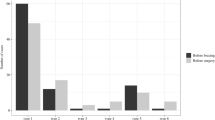Abstract
Since the introduction of Cotrel–Dubousset instrumentation in 1984, the correction techniques in scoliosis surgery have changed from Harrington principles of concave distraction to segmental realignment to a variety of possibilities including the rod rotation manoeuvres, and to segmental approximation via cantilever methods. Additionally, pedicle screw utilization in lumbar curves enhanced correction and stabilization of various deformities, and various studies have strongly supported the clinical advantages of lumbar pedicle screws versus conventional hook instrumentation. Pedicle screw constructs have become increasingly popular in the treatment of patients with spinal deformity. When applied to adolescent idiopathic scoliosis patients, pedicle screw fixation has demonstrated increased corrective ability compared with traditional hook/hybrid instrumentation. In our study, we do a retrospective review of idiopathic scoliosis patients (King 2–Lenke 1 B/C) treated with a selective thoracic posterior fusion using an all-screw construct versus a hybrid (pedicle screws and hooks) construct and, compare the percentage of correction of the scoliotic curves obtained with screws alone and screws and hooks. Special attention was given to the rod diameter and correction technique. Our results show that the percentage of correction of idiopathic thoracic scoliosis is similar when treating the scoliosis with rods and screws alone or with rods, screws and hooks; therefore, we and the majority of authors in the literature do not consider the rod section. This can be an important parameter in the evaluation of the superiority of treatment with screws only or screws and hooks. In our study, even if not of statistical significance, the better thoracic curve correction obtained with the hybrid group should be ascribed to the fact that in this group mostly 6 mm rods were used.



Similar content being viewed by others
References
Cotrel Y, Dubousset J (1984) A new technique for segmental spinal osteosynthesis using the posterior approach. Rev Chir Orthop Reparatrice Appar Mot 70:489–494
Harrington PR (1962) Treatment of scoliosis: correction and internal fixation by spine instrumentation. J Bone Jt Surg Am 44:591–610
Cotrel Y, Dubousset J, Guillaumat M (1988) New universal instrumentation in spinal surgery. Clin Orthop 227:10–23
Webb JK, Burwell RG, Cole AA et al (1995) Posterior instrumentation in scoliosis. Eur Spine J 4:2–5
Lehman RA Jr, Lenke LG, Keeler KA, Kim YJ, Buchowski JM, Cheh G, Kuhns CA, Bridwell KH (2008) Operative treatment of adolescent idiopathic scoliosis with posterior pedicle screw-only constructs: minimum three-year follow-up of one hundred fourteen cases. Spine (Phila Pa 1976) 33(14):1598–1604
Lowenstein JE, Matsumoto H, Vitale MG, Weidenbaum M, Gomez JA, Lee FY, Hyman JE, Roye DP Jr (2007) Coronal and sagittal plane correction in adolescent idiopathic scoliosis: a comparison between all pedicle screw versus hybrid thoracic hook lumbar screw constructs. Spine (Phila Pa 1976) 32(4):448–452
Brown CA, Lenke LG, Bridwell KH et al (1998) Complications of pediatric thoracolumbar and lumbar pedicle screws. Spine 23:1566–1571
Hamill CL, Lenke LG, Bridwell KH et al (1996) The use of pedicle screw fixation to improve correction in the lumbar spine of patients with idiopathic scoliosis. Spine 21:1241–1249
Gaines RW (2000) The use of pedicle-screw internal fixation for the operative treatment of spinal disorders. J Bone Jt Surg Am 82:1458–1769
Barr SJ, Schuette AM, Emans JB (1997) Lumbar pedicle screws versus hooks. Results in double major curves in adolescent idiopathic scoliosis. Spine 22:1369–1379
Dobbs MB, Lenke LG, Kim YJ et al (2006) Selective posterior thoracic fusions for adolescent idiopathic scoliosis: comparison of hooks versus pedicle screws. Spine 31:2400–2404
Kim YJ, Lenke LG, Cho SK et al (2004) Comparative analysis of pedicle screw versus hook instrumentation in posterior spinal fusion of adolescent idiopathic scoliosis. Spine 29:2040–2048
Suk SI, Kim WJ, Kim JH et al (1999) Restoration of thoracic kyphosis in the hypokyphotic spine: a comparison between multiple-hook and segmental pedicle screw fixation in adolescent idiopathic scoliosis. J Spinal Disord 12:489–495
Suk SI, Lee CK, Kim WJ et al (1995) Segmental pedicle screw fixation in the treatment of thoracic idiopathic scoliosis. Spine 20:1399–1405
Liljenqvist U, Hackenberg L, Link T et al (2001) Pullout strength of pedicle screws versus pedicle and laminar hooks in the thoracic spine. Acta Orthop Belg 67:157–163
Kuklo TR, Lenke LG, O’Brien MF et al (2005) Accuracy and efficacy of thoracic pedicle screws in curves more than 90 degrees. Spine 30:222–226
Halm H, Niemeyer T, Link T et al (2000) Segmental pedicle screw instrumentation in idiopathic thoracolumbar and lumbar scoliosis. Eur Spine J 9:191–197
Liljenqvist UR, Halm HF, Link TM (1997) Pedicle screw instrumentation of the thoracic spine in idiopathic scoliosis. Spine 22:2239–2245
Belmont PJ Jr, Klemme WR, Dhawan A et al (2001) In vivo accuracy of thoracic pedicle screws. Spine 26:2340–2346
Kim YJ, Lenke LG, Bridwell KH et al (2004) Free hand pedicle screw placement in the thoracic spine: is it safe? Spine 29:333–342 (discussion 2042)
Yu B, Zhang JG, Qiu GX, Wang YP, Zhao Y, Shen JX, Zhao H, Yang XY (2009) Posterior selective thoracic fusion in adolescent idiopathic scoliosis patients: a comparison of all pedicle screws versus hybrid instrumentation. Chin Med Sci J 24(1):30–35
Rose PS, Lenke LG, Bridwell KH, Mulconrey DS, Cronen GA, Buchowski JM, Schwend RM, Sides BA (2009) Pedicle screw instrumentation for adult idiopathic scoliosis: an improvement over hook/hybrid fixation. Spine (Phila Pa 1976) 34(8):852–857
Bullmann V, Liljenqvist UR, Schmidt C, Schulte TL (2009) Posterior operative correction of idiopathic scoliosis. Value of pedicle screws versus hooks. Orthopade 38(2):198–200, 202–204
Conflict of interest
None.
Author information
Authors and Affiliations
Corresponding author
Rights and permissions
About this article
Cite this article
Lamartina, C., Petruzzi, M., Macchia, M. et al. Role of rod diameter in comparison between only screws versus hooks and screws in posterior instrumentation of thoracic curve in idiopathic scoliosis. Eur Spine J 20 (Suppl 1), 85–89 (2011). https://doi.org/10.1007/s00586-011-1757-y
Received:
Published:
Issue Date:
DOI: https://doi.org/10.1007/s00586-011-1757-y




